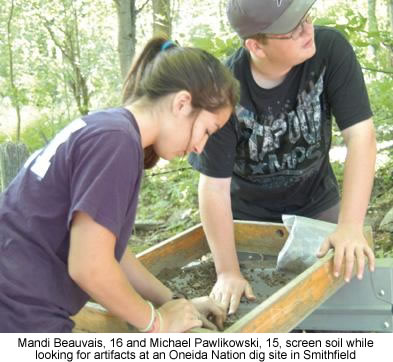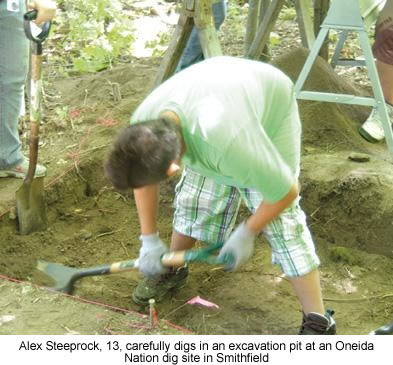 |
Canku Ota
|
 |
|
(Many Paths)
|
||
|
An Online Newsletter
Celebrating Native America
|
||
|
August 1, 2010 - Volume
8 Number 8
|
||
|
|
||
|
Young Oneidas Dig
Their History
|
||
|
by Matt Powers - The
Oneida (NY) Daily Dispatch Staff Writer
|
||
|
credits: photos by Matt
Powers - The Oneida (NY) Daily Dispatch Staff Writer
|
|
The archaeological dig at the Vallaincourt site is part of the six-week Youth Work/Learn summer program run by the Oneida Nation. "It gives them a little bit of an understanding of who they are and an understanding of where they come from," said Clint Hill, Oneida Nation Men's Council member. "Just to give them overall more of an understanding of themselves and the things that they can do." "We found quite a few artifacts," said Oneida Nation Historical Resources Specialist Jesse Bergevin. The group has unearthed pieces of pottery and arrowheads along with other objects like deer bones. Bergevin said the first few days are spent teaching the group what they should be looking for and how to dig the square excavation units. "It's fun finding the different bones and stuff," said 15-year-old Michael Pawlikowki, of Verona. He said he has been learning a lot about the history of the Oneidas. "This site was occupied around 1550 to 1575," Bergevin said. "This is one of the Oneida villages. So this would have been possibly the main village during that time period. This would have been where the vast majority of Oneidas were at that point. For all the Oneidas today, these would have been direct ancestors." The Youth Work/Learn program began in 1991 and is open to young people from ages 13 to 20, according to the Nation's website. "We want them to know that there's more to summer than sitting around the house and watching TV," said Hill. "We want to get them outside and into the woods which is something that most kids don't do nowadays."
"They need to understand the history of where they came from which is something I was taught when I was young," said Hill. "As I was growing up around here I noticed a lot of these kids didn't know their language, didn't know the history of where the Oneidas came from. All they knew was that they were Oneida. I think as a Nation and as a council we wanted to make a change in that. So, 20 years ago we started the youth program." Bergevin said the archaeological dig is one way to find that identity. "It gives them, first of all, kind of a hands-on opportunity to re-experience their past," he said. "Also, to have a chance to look at the artifacts and interpret their own history. Typically, for the past couple of hundred years, it has been Europeans and European descendants that have been interpreting the history and the archeology of the area." He said with sites like these the kids have a chance to get "involved in actually having a hands-on understanding and appreciation of what the history is and to have complete control over what's going on. It's no longer being told what history is because they actually get to experience it and have it right at their finger tips." He said the artifacts will be curated by the Oneida Nation. "We have an archival facility that they go in once they're looked at, analyzed and recorded," he said. "We use that to add to the information that is already available on this site." Youth Work Crew Supervisor Dana Smith has been working with students in the program for a few years and said every year is different. "You work with different kids and you really have to adjust to get to know them," she said. "You have to adjust to their personalities and work styles. You can never assume that they know how to do a specific job so there is a lot of teaching and instructing going on." She said she likes the program because it provides the opportunity to do things many people do not get the chance to do such as studying the Oneida language and being part of an archaeological dig. She said it is important that the program continues because it gives students "a sense of history and a sense of belonging." |
|
|
||
|
|
||
| Canku Ota is a free Newsletter celebrating Native America, its traditions and accomplishments . We do not provide subscriber or visitor names to anyone. Some articles presented in Canku Ota may contain copyright material. We have received appropriate permissions for republishing any articles. Material appearing here is distributed without profit or monetary gain to those who have expressed an interest. This is in accordance with Title 17 U.S.C. Section 107. | ||
|
Canku Ota is a copyright ©
2000, 2001, 2002, 2003, 2004, 2005, 2006, 2007, 2008, 2009, 2010
of Vicki Barry and Paul Barry.
|
||
 |
 |
|
|
The "Canku
Ota - A Newsletter Celebrating Native America" web site and
its design is the
|
||
|
Copyright ©
1999, 2000, 2001, 2002, 2003, 2004, 2005,
2006, 2007, 2008, 2009, 2010
of Paul C. Barry.
|
||
|
All Rights Reserved.
|
||
 SMITHFIELD
— A group of Oneida Nation young people spent the past week
excavating an archaeological site hidden back in the woods which
was once home to their tribe hundreds of years ago.
SMITHFIELD
— A group of Oneida Nation young people spent the past week
excavating an archaeological site hidden back in the woods which
was once home to their tribe hundreds of years ago. The
program also includes hour-long Oneida language classes.
The
program also includes hour-long Oneida language classes.